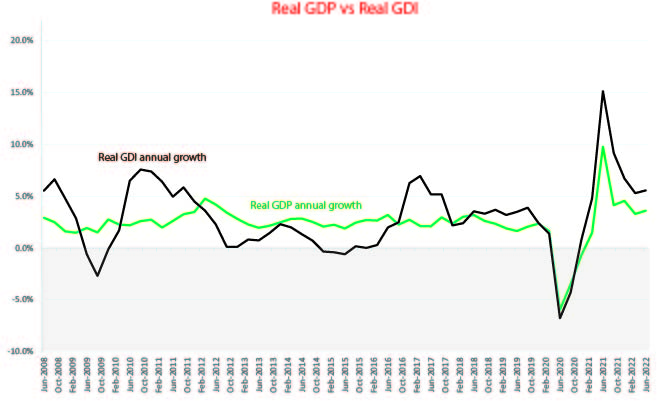Activity 5b:
[Extension] An income recession vs a technical recession?

- Assuming that the rate of growth is above 0 but below 2%, it might not increase material living standards if the rate of population growth exceeds 2%. This is because the rate of growth in real GDP per capita (which is one measure of material living standards) will decline. In addition, if real GDP growth is approximately 2% and population growth is assumed to be 0, then this might not translate into higher material living standards if growth in real incomes (e.g. as measured by Gross Domestic income) falls over the same period (e.g. due to a large fall in the terms of trade).
- Real GDP measures national production whereas real GDI measures national income. The major difference between the two is the treatment of movements in commodity prices (or terms of trade). Real GDP extracts the effects of the terms of trade so that an increase in the commodity prices/terms of trade will not directly affect real GDP. In contrast, real GNI includes the effects of changes in the terms of trade, such that an increase in the terms of trade will necessarily result in an increase in real GNI.
- This is because of the large falls in the terms of trade that occurred over 2012 and 2015. This means that the fall in export prices (which was a driving force behind the falling terms of trade) did not directly impact on production volumes as measured by real GDP, but it did directly impact on the incomes received by exporters (e.g. miners receiving less sales revenue from any given volume of mining exports). This resulted in national income (as measured by GDI) falling despite the growth in production volumes (or real GDP) remaining positive.
- A recession occurs when there is a fall in real GDP for two consecutive quarters (i.e. economic growth is negative for two quarters). In contrast, an income recession occurs when there is a fall in national income for two consecutive quarters (i.e. growth in GDI is negative for two quarters).
- Changes in real GDI (or real GDI per capita) are commonly regarded to be a better measure of living standards in comparison to changes in real GDP (or real GDP per capita). This is because incomes received from production, rather than the actual amount of production that has occurred, provide the means by which Australians can purchase goods and services.
- Since 2020, the growth in real GDI and real GDP increased from approximately -5% to more than 9% in 2021 Before falling back towards 5%. However, the growth in real GDI exceeded the growth in real GDP over the period (by as much as five percentage points during 2021) due to the large increase in the terms of trade over the period (to the highest ever recorded).
[Note: given that changes in commodity prices or the terms of trade is the major factor behind the difference between real GDP and real GDI, any period of little variation in the terms of trade will mean that the movement in real GDP and real GDI will effectively be the same.]
